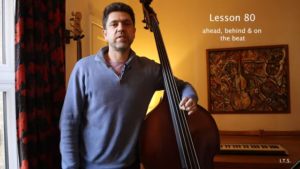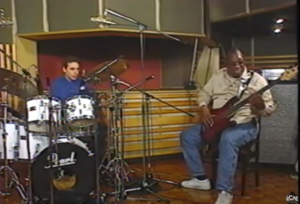CHAPTER 3: PERSONAL DEVELOPMENT(パーソナルデベロップメント)
When people recall their favorite opera singers or classical instrumental soloists, the underlying musical contributors tend to be overlooked. Who, after all, is violinist Itzhak Perlman’s regular accompanist?15 – Paul Hofmann
オペラ歌手やクラシック楽器奏者のお気に入りのアーティストを思い出すとき、裏方の音楽家はしばしば見落とされています。だって、例えばヴァイオリニストのイツァーク・パールマンの定期的な伴奏者って誰だろう? - ポール・ホフマン
Influences, inspirations and early development(影響、インスピレーション、早期の発展)
The eight artists interviewed for this project learned their craft in their own unique ways. Most artists in the study acknowledged the outstanding jazz vocal accompanists of the past as influential in some way. Randy Halberstadt was influenced not only by piano accompanists Ralph Sharon, Bill Evans and Tommy Flanagan, but also by pianists who accompanied themselves, such as Shirley Horn and Diana Krall.16 David Newton shares with Halberstadt his admiration of Horn, particularly appreciating her use of space on the Here’s to Life album.17 Larry Dunlap cites the duo recording of Andre Previn and Doris Day as a favorite, as well as Gary McFarland’s recordings with Bill Evans, Stan Getz and Steve Kuhn.18
このプロジェクトのためにインタビューされた8人のアーティストは、それぞれ独自の方法で技術を習得しました。研究対象の多くのアーティストは、過去の優れたジャズボーカルの伴奏者が何らかの形で影響を与えたと認めています。Randy Halberstadtは、ピアノの伴奏者であるRalph Sharon、Bill Evans、Tommy Flanaganだけでなく、Shirley HornやDiana Krallなど自分自身で伴奏するピアニストにも影響を受けました。David NewtonはHalberstadtと同じく、Here's to Lifeアルバムでの彼女のスペースの使い方を特に称賛しています。Larry Dunlapは、André PrevinとDoris Dayのデュオ録音や、Gary McFarlandのBill Evans、Stan Getz、Steve Kuhnとの録音をお気に入りのものとして挙げています。
Eric Gunnison names three recordings with piano accompanists that were influential in his development: Jimmy Rowles on Carmen McRae’s The Great American Songbook, Bill Evans on the Tony Bennett duo sessions, and Oscar Peterson on Ella and Oscar.19 Peterson’s busy accompaniment style, contrasted to the more minimal Rowles and Evans, had equal influence on Gunnison’s conception of vocal accompaniment.20
エリック・ガンニソンは、彼の技術の発展に影響を与えたピアノ伴奏の録音として、カーメン・マクレエの「グレート・アメリカン・ソングブック」でのジミー・ロウルズ、トニー・ベネットとのデュオ・セッションでのビル・エヴァンス、そしてエラ・フィッツジェラルドとオスカー・ピーターソンのデュオでのオスカー・ピーターソンの3つを挙げています。ペターソンの活発な伴奏スタイルは、より控えめなロウルズとエヴァンスとは対照的であったが、ガンニソンのヴォーカル伴奏の概念に同等の影響を与えたと語っています。
John Colianni cites Carlton Drinkard, who accompanied Billie Holiday from around 1948 to the late 1950’s, as an early teacher and mentor.21 Drinkard wasn’t a “notey” player, but Colianni learned a great deal about Drinkard’s “restraint and a sparser deployment of notes and chords.” Like Halberstadt, Colianni was fascinated by Ralph Sharon’s work with Tony Bennett. He described Sharon as “a beautifully tasty and an extremely colorful and inventive player. Like Carlton, he played far fewer notes than a Peterson-fashioned player like me. His substitutions and voicings and rhythmic approach really appealed to me and inspired me. He gave Tony Bennett a terrific musical framework within which to sing.”22 Tommy Flanagan is another of Colianni’s favorites, particularly his accompaniment on the Ella Fitzgerald recording, At the Montreux Jazz Festival 1975: “I thought of his approach as crystalline and elegant and soulful at the same time. I also liked Bobby Short's self-accompaniment for the same reason; it was jazz conscious and swung a lot, but it also captured the mood of whatever material was being sung.” These accompanists showed Colianni how versatile and chameleon-like a good accompanist must be.
ジョン・コリアーニは、ビリー・ホリデイを約1948年から1950年代後半まで伴奏していたカールトン・ドリンカードを初期の教師として挙げています。ドリンカードは、「音が多い」プレイヤーではなかったが、コリアーニは彼の「自制心とより少ない音符とコードの展開」から多くを学んだと述べています。ハルバースタットと同様に、コリアーニはトニー・ベネットとのラルフ・シャロンの仕事に魅了されました。彼はシャロンを「美味しく、非常にカラフルで創造的なプレイヤー」と表現し、「私のようなPeterson系のプレイヤーと比べて、彼はずっと少ない音符を演奏していた。彼の代替コードや和音進行、リズミカルなアプローチは私を本当に魅了し、私をインスパイアしてくれた。彼はトニー・ベネットに優れた音楽的枠組みを提供しました。」トミー・フラナガンもコリアーニのお気に入りの一人であり、特にエラ・フィッツジェラルドのアルバム『At the Montreux Jazz Festival 1975』での伴奏に注目しています。「彼のアプローチは、クリスタルのようにエレガントでソウルフルなものでした。また、ボビー・ショートの自己伴奏も同じ理由で好きでした。それはジャズ意識があり、多くのスウィングを持っていましたが、歌われている曲のムードも捉えていた」と語っています。これらの伴奏者たちは、優れた伴奏者がどれだけ多才でカメレオンのようであるべきかをコリアーニに示してくれました。
Ella Fitzgerald / At the Montreux Jazz Festival 1975
John di Martino’s parents introduced him to great Broadway musicals at a young age.23 He credits his sensitivity to vocal music to this early exposure to the Great American Songbook. He cites June Christy’s “Something Cool” and Gloria Lynne’s “Folks Who Live on the Hill” as recordings influential to his development. His early models for accompanying were Hank Jones, whom he admired for his “beautiful touch,” and later Mike Renzi for his sympathetic rapport with Mel Tormé. He also appreciates the orchestral work of Gil Evans and Claus Ogermann and credits them for his own orchestral approach to accompanying.
ジョン・ディ・マルティノは幼い頃に両親から優れたブロードウェイミュージカルを紹介されました。彼はこれらの素晴らしいアメリカの歌曲に早い段階で接していたことが、彼のヴォーカル音楽に対する感受性に影響を与えたと述べています。彼は、自分の成長に影響を与えたレコーディングとして、ジューン・クリスティの「Something Cool」とグロリア・リンの「Folks Who Live on the Hill」を挙げています。彼の初期の伴奏者のモデルは、美しいタッチを持つハンク・ジョーンズと、メル・トーメとの共感的な連携で称賛されたマイク・レンジでした。また、彼は、ギル・エヴァンスとクラウス・オゲルマンのオーケストラ作品を高く評価し、自身のオーケストラによる伴奏手法に彼らが影響を与えたと述べています。
Gloria Lynne / Folks Who Live on the Hill
Laurence Hobgood, on the other hand, was more immersed in instrumental jazz before he studied vocal accompanists: “I didn’t listen to Ralph Sharon, I listened to Herbie Hancock, who is probably the greatest accompanist in jazz in general.”24 Though Hancock has recorded with few jazz vocalists, Hobgood still credits much of his accompaniment approach to Hancock’s influence.25 Hobgood also indicates a recording of Chick Corea accompanying Nancy Wilson on “My One and Only Love” as particularly inspirational, noting Corea’s careful listening and following of Wilson. “The recording was musically extraordinary. That should be the goal of any singer or any pianist. The goal should be to come up with an extraordinary performance,” he adds. On this rubato ballad performance, Corea’s inventive use of dynamics, space, adventurous harmonic excursions and single note line fills do not interfere with Wilson’s vocals.26
一方、ローレンス・ホブグッドは、ヴォーカル伴奏を学ぶ前に、より器楽ジャズに没頭していました。「私はラルフ・シャロンではなく、ハービー・ハンコックを聴いていました。おそらく、彼はジャズ全般で最も優れた伴奏者です」と彼は言います。ハンコックはほとんどのジャズヴォーカリストと録音していませんが、ホブグッドは依然として彼の伴奏手法の多くをハンコックの影響によるものと考えています。彼はまた、チック・コリアが「My One and Only Love」でナンシー・ウィルソンを伴奏した録音を特にインスピレーションに挙げ、コリアがウィルソンに注目して追随していることに注目しています。「その録音は音楽的に非常に優れていました。それがどんな歌手やピアニストの目標であるべきかです。目標は、非常に優れたパフォーマンスを生み出すことです」と彼は付け加えます。このルバート・バラードの演奏で、コリアは動きのあるダイナミック、空間、冒険的な和音の冒険、そしてシングルノートラインのフィルでウィルソンのボーカルに干渉することはありません。
Nancy Wilson - Chick Corea / My One and Only Love
Living up to his own assessment of good accompanying, Corea’s accompaniment indeed stands on its own as a melody. Like Hobgood, Corea himself was greatly inspired by Herbie Hancock’s melodic and sympathetic accompanying of Miles Davis, particularly on the track “My Funny Valentine” from Four and More.27
自分自身の良い伴奏の評価に応えるように、コレアの伴奏は実際にはメロディーそのものとして存在しています。ホブグッドと同様に、コレア自身もマイルス・デイヴィスとの共演におけるハービー・ハンコックのメロディアスで共感的な伴奏に大いに感銘を受け、特に「Four and More」の「My Funny Valentine」での演奏に影響を受けたと語っています。
Miles Davis / My Funny Valentine - My Funny Valentine
Influences beyond jazz(ジャズ以外の影響)
Stylistic influences outside jazz vary greatly among the participants, but most are influenced by both classical and popular music in some way. From personal experience, I feel that an understanding of other styles of music makes an accompanist more versatile and adaptable, and allows for greater expression while supporting the vocalist. For example, textural and orchestral ideas in the music of composers as diverse as Ravel, Beethoven and the Beatles can be creatively applied to the accompaniment of the jazz vocalist.
ジャズ以外のスタイルの影響は参加者によって大きく異なりますが、ほとんどの人は何らかの形でクラシックやポピュラー音楽に影響を受けています。私自身の経験から言えることは、他の音楽のスタイルを理解することで、伴奏者はより多様性に富み、適応力があり、ボーカリストを支えながらより表現力豊かに演奏できるようになると思います。例えば、ラヴェルやベートーヴェン、ビートルズのような多様な作曲家の音楽におけるテクスチャーやオーケストラのアイデアは、ジャズボーカルの伴奏に創造的に応用することができます。
Eric Gunnison and John di Martino cite a wide range of musical influences beyond jazz. The vocal music of Charles Ives and some of the early recordings of Aretha Franklin singing standards inspired Gunnison, while Richard Strauss heavily influenced di Martino’s concept of orchestration.
エリック・ガニソンとジョン・ディ・マルティーノは、ジャズ以外の幅広い音楽的影響を引用しています。チャールズ・アイヴズのボーカル音楽や、スタンダードを歌うアレサ・フランクリンの初期の録音が、ガニソンをインスピレーションの源としており、リチャード・シュトラウスはディ・マルティーノのオーケストレーションのコンセプトに強い影響を与えました。
Larry Dunlap was highly influenced by Brazilian music, particularly the work of Antonio Carlos Jobim. Popular music of the 1960's such as the Beatles, and folk music of 1960’s artists Joni Mitchell, Crosby, Stills and Nash and James Taylor were also early favorites. Dunlap also enjoys Broadway shows, as well as classical composers Shostokovich, Bach, Brahms, Mozart and Copland. Like Dunlap, Halberstadt was also influenced by Brazilian music, particularly Sergio Mendes and Brasil 66.
ラリー・ダンラップは、特にアントニオ・カルロス・ジョビンの作品に影響を受けました。ビートルズの60年代のポピュラー音楽や、ジョニ・ミッチェル、クロスビー、スティルス、ナッシュ、ジェームズ・テイラーなどの60年代のフォーク音楽が初期のお気に入りでした。ダンラップはまた、ブロードウェイショー、ショスタコーヴィチ、バッハ、ブラームス、モーツァルト、コープランドなどのクラシック音楽も楽しんでいます。ハルバースタットもダンラップと同様、特にセルジオ・メンデスとブラジル66に影響を受けました。
John Colianni has had a particularly diverse career, enjoying accompanying in many styles including jazz, pop, rock, country and blues. He backed Mel Tormé for six years and he continues to accompany pop artist Steve Miller. Through rock and soul music, Colianni picked up a taste for harmony that was more guitar-oriented. He enjoyed rock groups like the Beatles, Rolling Stones, Kiss, Led Zeppelin and soul artists such as Earth Wind and Fire, Al Green, Isaac Hayes and Lou Rawls. These soul artists were particular favorites for Colianni, because “the harmony was noticeably much more piano- oriented” with evident jazz origins.
ジョン・コリアーニは、ジャズ、ポップ、ロック、カントリー、ブルースなど、多様なスタイルでの伴奏を楽しんできた、特に多様なキャリアを持つ人物です。彼は6年間メル・トーメを支え、現在もポップアーティストのスティーブ・ミラーを伴奏しています。コリアーニはロックやソウルミュージックを通じて、よりギター指向のハーモニーに興味を持ちました。ビートルズ、ローリングストーンズ、Kiss、レッド・ツェッペリンなどのロックグループ、Earth Wind and Fire、Al Green、Isaac Hayes、Lou Rawlsなどのソウルアーティストが好きでした。これらのソウルアーティストは、明らかなジャズの起源があり、ハーモニーが明らかにピアノ指向であるため、特にコリアーニのお気に入りでした。
Hobgood’s background is unique since he had a “compositional consciousness” gleaned from the University of Illinois at Urbana-Champaign composition department. In the late 1970’s and early 1980’s his composition teachers Herbert Brün and Salvatore Martirano helped pave the way for his future musical thought: “It was very twentieth century. The abstract nature of that music and the conceptionalization of it that I was exposed to definitely had a big influence on everything and especially on my accompanying.” This compositional thinking also affected the way Hobgood would accompany vocalists, notably the instrumentally-oriented vocalist Kurt Elling.
ホブグッドの背景は独特で、イリノイ大学アーバナ・シャンペーン校の作曲科から得た「作曲意識」がありました。1970年代後半から1980年代初頭にかけて、作曲の先生であるハーバート・ブリュンとサルバトーレ・マルティラーノが、彼の将来の音楽的思考を開拓するのに役立ちました。「それは非常に20世紀的でした。その音楽の抽象的な性質と私が露出した概念化は、すべてに大きな影響を与えました。特に私の伴奏に影響を与えました」と彼は述べています。この作曲的な思考は、器楽中心のボーカリスト、特にカート・エリングを伴奏する方法にも影響を与えました。
Growing up in the 1960’s, David Newton was influenced by folk-rock artists Carole King and Joni Mitchell.28 On “What the World Needs Now” from Stacey Kent’s The Boy Next Door, Newton brings these influences into his playing, citing that original recordings of songs such as these made by Dionne Warwick and others influenced his approach to the accompaniment.
1960年代に育ったDavid Newtonは、フォークロックアーティストのCarole KingやJoni Mitchellの影響を受けました。彼はStacey Kentのアルバム「The Boy Next Door」の「What the World Needs Now」では、Dionne Warwickなどがレコーディングしたオリジナルの楽曲が彼の伴奏アプローチに影響を与えたと述べ、これらの影響を演奏に反映させています。
Stacey Kent / The Boy Next Door - What the World Needs Now
The factors involved in tracing the lineage and effect of musical influences on a musician are complicated. Influences can work indirectly at the subconsious level. It is no surprise that based on the necessity of versatility and adaptability of the pianists interviewed for this project, a wide variety of musical influences shaped their musicality. Perhaps a desire to sublimate the ego by specializing in the area of accompanying is an inherent trait in one’s personality. This psychological question, however interesting, is beyond the scope of this project.
音楽的な影響の系統を追跡し、それが音楽家に及ぼす影響を分析するために必要な要素は複雑です。影響は潜在意識のレベルで間接的に働くことがあります。このプロジェクトのためにインタビューしたピアニストたちが多才で適応力がある必要性に基づいて、多様な音楽的な影響が彼らの音楽性を形成する上で重要であったことは驚くべきことではありません。伴奏の分野で専門的になって自己を昇華させたいという欲求が、人格の本質的な特性の中にあるかもしれません。しかしながら、この心理学的な問題は興味深いとはいえ、このプロジェクトの範囲外です。

